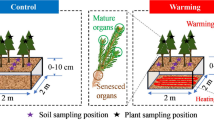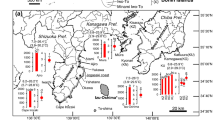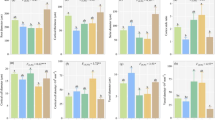Abstract
We investigated the responses of growth and non-structural carbohydrates to submergence and de-submergence in three wetland macrophyte species. Survival rate, recovery ability, and soluble sugar and starch contents of flood-tolerant Polygonum hydropiper and of flood-sensitive Phalaris arundinacea and Carex argyi from Dongting Lake wetlands were investigated after 20, 40, and 60 days of complete submergence without light and 10 days after de-submergence. Plant dry weight and soluble sugar and starch contents decreased in all species during the submergence period. The decreases were slowest in P. hydropiper, intermediate in C. argyi, and most rapid in P. arundinacea. After 60 days of submergence, survival rates were 100, 50, and 0 % in P. hydropiper, C. argyi, and P. arundinacea, respectively. After recovery, plant dry weight increased in P. hydropiper and in C. argyi, but decreased in P. arundinacea. Compared to pre-submergence, soluble sugar contents generally increased and then remained relatively constant after recovery in all species, while starch content increased in P. hydropiper and decreased in P. arundinacea with increasing submergence time. For C. argyi, starch content decreased after recovery from the 20-day submergence, but increased after recovery from the 40- and 60-day submergences. These data illustrate mechanisms behind the flood tolerance of P. hydropiper and the sensitivity to flooding in P. arundinacea and C. argyi. These mechanisms include lower consumption and quicker accumulation of non-structural carbohydrates in flood-tolerant plants.

Similar content being viewed by others
References
Bond BJ, Midgley JJ (2001) Ecology of sprouting in wood plants: the persistence niche. Trends Ecol Evol 16:45–51
Braendle R, Crawford RMM (1999) Plants as amphibians. Persp Plant Ecol Evol Sys 2:56–78
Colmer TD, Voesenek LACJ (2009) Flooding tolerance: suites of plant traits in variable environments. Funct Plant Biol 36:665–681
Das KK, Sarkar RK, Ismail AM (2005) Elongation ability and non-structural carbohydrate levels in relation to submergence tolerance in rice. Plant Sci 168:131–136
Fritz KM, Dodds WK (2004) Tolerance and resilience of macroinvertebrate assemblages to drying and flood in a tall grass prairie stream system. Hydrobiologia 527:99–112
Gibbs J, Greenway H (2003) Review: mechanisms of anoxia tolerance in plants. I. Growth, survival and anaerobic catabolism. Funct Plant Biol 30:353
Kawano N, Ito O, Sakagami JI (2009) Morphological and physiological responses of rice seedlings to complete submergence (flash flooding). Ann Bot 103:161–169
Langhans SD, Tockner K (2006) The role of timing, duration, and frequency of inundation in controlling leaf litter decomposition in a river-floodplain ecosystem (Tagliamento, northeastern Italy). Oecologia 147:501–509
Li YZ, Xie YH, Ren B, Luo WB, Huang JS (2007) Oxygen enhances the recovery of Potamogeton maackianus from prolonged exposure to very low irradiance. Aquat Bot 86:295–299
Li F, Li YZ, Qin HY, Xie YH (2011) Plant distribution can be reflected by the different growth and morphological responses to water level and shade in two emergent macrophyte seedlings in the Sanjiang Plain. Aquat Ecol 45:89–97
Loreti E, Yamaguchi J, Alpi A, Perata P (2003) Sugar modulation of α-amylase genes under anoxia. Ann Bot 91:143–148
Luo WB, Song FB, Xie YH (2008) Trade-off between tolerance to drought and tolerance to flooding in three wetland plants. Wetlands 28:866–873
Luo FL, Nagel KA, Scharr H, Zeng B, Schurr U, Matsubara S (2011) Recovery dynamics of growth, photosynthesis and carbohydrate accumulation after de-submergence: a comparison between two wetland plants showing escape and quiescence strategies. Ann Bot 107:49–63
Ma T, Wu GL, He YL, Wen SJ, He JL, Liu JX, Du GZ (2007) The effect of simulated mowing of the fertilizing level on community production and compensatory resposes on the Qinhai-Tibetan. Acta Ecol Sinic 27:2288–2293 (in Chinese)
Mommer L, Lenssen JPM, Huber H, Visser EJW, De Kroon H (2006) Ecophysiological determinants of plant performance under flooding: a comparative study of seven plant families. J Ecol 94:1117–1129
Pan Y, Xie Y, Li F, Pan BH (2012a) Morphological and physiological responses to burial depth and sediment type in the wetland macrophyte Miscanthus sacchariflorus. Fundam Appl Limnol 180:271–277
Pan Y, Xie Y, Chen X, Li F (2012b) Effects of flooding and sedimentation on the growth and physiology of two emergent macrophytes from Dongting Lake wetlands. Aquat Bot 100:35–40
Panda D, Sharma SG, Sarkar RK (2008) Chlorophyll fluorescence parameters, CO2 photosynthetic rate and regeneration capacity as a result of complete submergence and subsequent re-emergence in rice (Oryza sativa L.). Aquat Bot 88:127–133
Peña-Fronteras JT, Villalobos MC, Baltazar AM, Merca FE, Ismail AM, Johnson DE (2009) Adaptation to flooding in upland and lowland ecotypes of Cyperus rotundus, a troublesome sedge weed of rice: tuber morphology and carbohydrate metabolism. Ann Bot 103:295–302
Sarkar RK, Reddy JN, Sharma SG, Ismail AM (2006) Physiological basis of submergence tolerance in rice and implications for crop improvement. Curr Sci India 91:899–906
Schlüter U, Crawford RMM (2001) Long-term anoxia tolerance in leaves of Acorus calamus L. and Iris pseudacorus L. J Exp Bot 52:2213
Van Eck WHJM, Lenssen JPM, Rengelink RHJ, Blom CWPM, De Kroon H (2005) Water temperature instead of acclimation stage and oxygen concentration determines responses to winter floods. Aquat Bot 81:253–264
Vartapetian BB, Jackson MB (1997) Plant adaptations to anaerobic stress. Ann Bot 79:3–20
Vriezen WIMH, Zhou ZY, van der Straeten D (2003) Regulation of submergence-induced enhanced shoot elongation in Oryza sativa L. Ann Bot 91:263–270
Webb T, Armstrong W (1983) The effects of anoxia and carbohydrates on the growth and viability of rice, pea and pumpkin roots. J Exp Bot 34:579–603
Ye XQ (2010) Carbohydrate concentration and tolerance in three riparian plant species from the Three Gorges Reservoir region exposed to long-term submergence. Institut für Systematische Botanik und Ökologie Universität Ulm
Yemm EW, Willis AJ (1954) The estimation of carbohydrates in plant extracts by anthrone. Biochem J 57:508–514
Zheng JM, Wang LY, Li SY, Zhou JX, Sun QX (2009) Relationship between community type of wetland plants and site elevation on sandbars of the East Dongting Lake, China. For Stud China 11:44–48
Acknowledgments
The authors greatly appreciate Prof E. Gross and two anonymous reviewers for providing constructive suggestions on earlier version of this article. This study was supported by the National Basic Research Program of China (2012CB417000), the Knowledge Innovation Program of the Chinese Academy of Sciences (ISACX-LYQY-QN-1208), and the National Natural Science Foundation of China (31170342; 31200271).
Author information
Authors and Affiliations
Corresponding author
Additional information
Communicated by J. Zwiazek.
Rights and permissions
About this article
Cite this article
Qin, X., Li, F., Chen, X. et al. Growth responses and non-structural carbohydrates in three wetland macrophyte species following submergence and de-submergence. Acta Physiol Plant 35, 2069–2074 (2013). https://doi.org/10.1007/s11738-013-1241-x
Received:
Revised:
Accepted:
Published:
Issue Date:
DOI: https://doi.org/10.1007/s11738-013-1241-x




